Hugging the Shore: A Paddler’s Guide to the Lower Bay’s State Parks
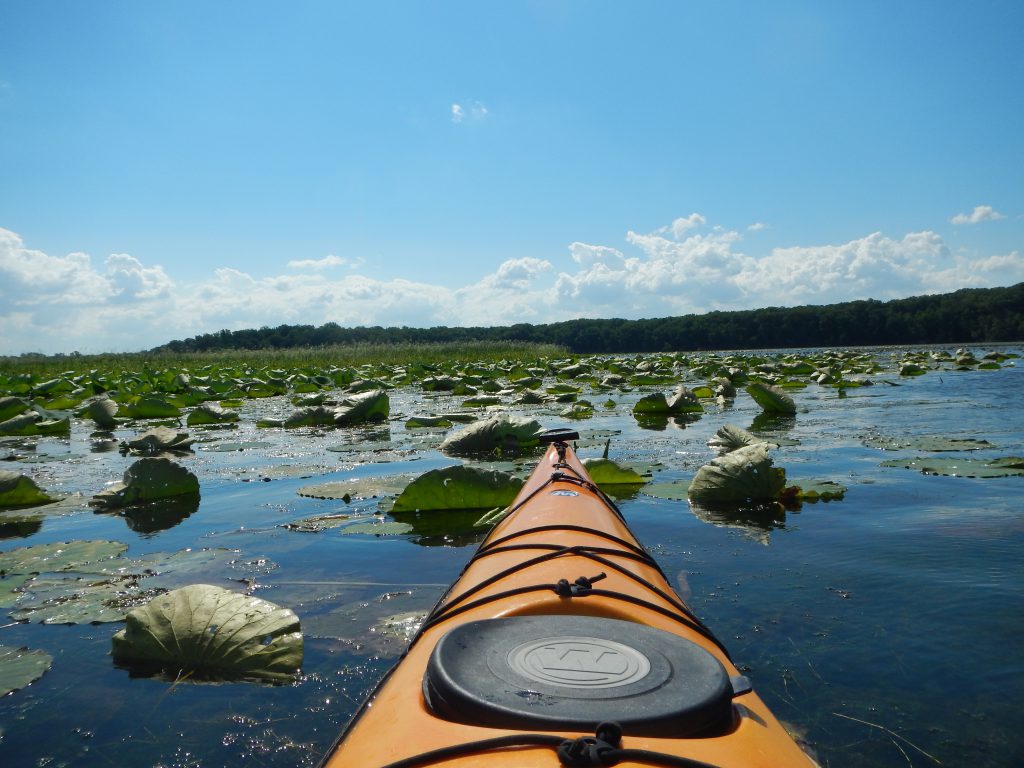
Kayak view; by Melissa Boyle Acuti
Warmer weather is on the way, and it’s a great time to get out and explore Maryland by kayak, canoe or paddleboard. Maryland’s public lands and waters provide some of the best paddling opportunities on the eastern seaboard. Here are some of the top spots in the lower Chesapeake Bay.
Point Lookout State Park
Located where the Potomac River meets the Chesapeake Bay, Point Lookout State Park is the southernmost point on Maryland’s western shore. Being surrounded by water on three sides makes it ideal for both beautiful sunrises and sunsets.
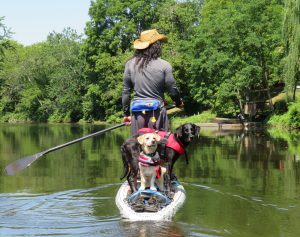
Stand-up paddleboarding with dogs; by Norma Broadwater
Lake Canoy at Point Lookout is a wonderful place for a canoe, kayak or paddleboard, especially when you want to be a bit more sheltered. The name is misleading as it’s not actually a lake, but rather a shallow body of water connected to the Potomac River, near the park’s boat launch. Paddlers can launch directly from the boat launch or from behind the park store where there is a small sandy spot off the parking lot. The park store also rents kayaks, canoes and paddleboards, but make sure you call ahead for hours. There’s also a launch point from the campground for those who get one of the popular waterfront campsites in Green’s Loop. Campsites can be booked up to one year in advance, and are quite popular on weekends during the summer. If you have the option to visit during the week, or in September or early fall, it’s a bit less busy and often the weather is still very nice!
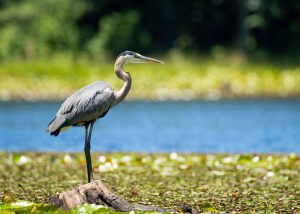
Blue heron; by Evelyn Henderson
Paddlers in Lake Canoy should be sure to take time to enjoy the wildlife all around. There is a small heron rookery, or nesting colony, between the causeway and the park store. From late spring to early summer, those who look and listen will see great blue herons coming and going, building nests and feeding young. If you listen carefully, you may even hear the young herons “clacking” and begging for food! There are also plenty of bald eagles and ospreys in this area, including an eagle nest that’s been active many years in the top of a large pine across from the boat launch, on what’s called Treasure Island. The nest typically yields two young each year. It takes about five years for the young eagles to get their “bald” heads; the
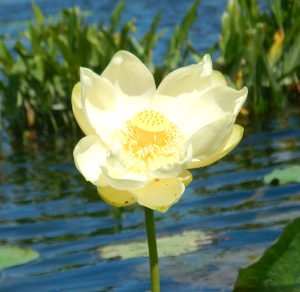
American lotus in bloom; by Melissa Boyle Acuti
juvenile eagles maintain a dark, blotchy appearance until then. Osprey can also be seen nesting on man-made nest “towers” or platforms throughout the park, as well as using some dead tree snags. Watch for these noisy “fish hawks” building nests and fishing from spring to summer.
Newtowne Neck State Park and St. Clements Island State Park
One of Maryland’s newest parks, Newtowne Neck is located in St. Mary’s County, just outside of Leonardtown off the Potomac River between Breton Bay and St. Clements Bay. The 700-plus acre property was purchased by the state in 2009 and has more than seven miles of shoreline, plenty for a short paddle. For a longer day trip, paddle out to St. Clements Island, where Maryland’s first English settlers landed in 1634. The island, which
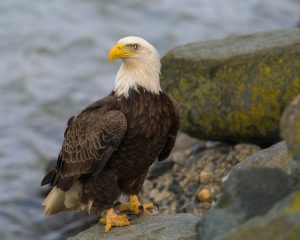
Bald eagle; by Mark Boyd
encompasses a 62-acre state park, includes a replica of the Blackistone Lighthouse, as well as a picnic pavilion, tables, grills and composting toilets. Camping is not allowed on St. Clements Island, so paddlers can take a break and refuel before heading back to Newtowne Neck, or continue along the Captain John Smith Trail on the Potomac River.
Janes Island State Park
If there were a park known to be a paddler’s playground, it would have to be Janes Island, with almost 30 miles of water trails! Located on the Eastern Shore, in Crisfield, this park is surrounded by water, and offers some of the best sunsets anywhere. Janes Island has a large variety of camping accommodations, from a small conference center to full service cabins that can sleep six, to rustic four-person mini-cabins and a campground with water and electric. There are also several more “primitive” paddle-in campsites that can only be accessed by boat. Exploring all around the island makes for an enjoyable adventure, and paddlers should make sure to check out the old fish factory remains. The beaches are beautiful and stretch on for miles. This is truly a gem on the Chesapeake Bay, and a trip here should include a stop at one of Crisfield’s many restaurants for a crab cake and slice of Maryland’s state dessert, Smith Island cake.
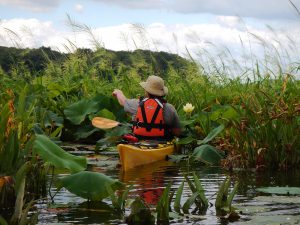
Kayaker among American lotus and wild rice on Mattawoman Creek; Melissa Boyle Acuti
Mattawoman Creek Natural Area
The Mattawoman Creek Natural Area in Charles County is an expansive estuary teeming with life and perfect for a relaxing paddle. While not technically a park, this area is owned by the state and managed by the Maryland Park Service. Mattawoman Creek is best known for its large variety of wildlife, especially birds, and the rare American lotus, which blooms late in the summer. The large and fragrant yellow blooms, among the giant lily pads of the lotus plants, can only be found in two places in Maryland. Paddling along these lotus blooms should be on your kayak “must do” list!
Always remember to follow Leave No Trace ethics when visiting this area: take only photos, leave only paddle strokes and please do not pick the flowers!
With these and many other adventures in our own backyard, it’s time to grab your personal flotation device and paddle and get out on the water exploring!

Kayak fishing; department photo
Article by Ranger Melissa Boyle Acuti—chief of interpretation for the Maryland Park Service. Appears in Vol. 22, No. 2 of the Maryland Natural Resource magazine, spring 2019.


 1-888-373-7888
1-888-373-7888 233733
233733